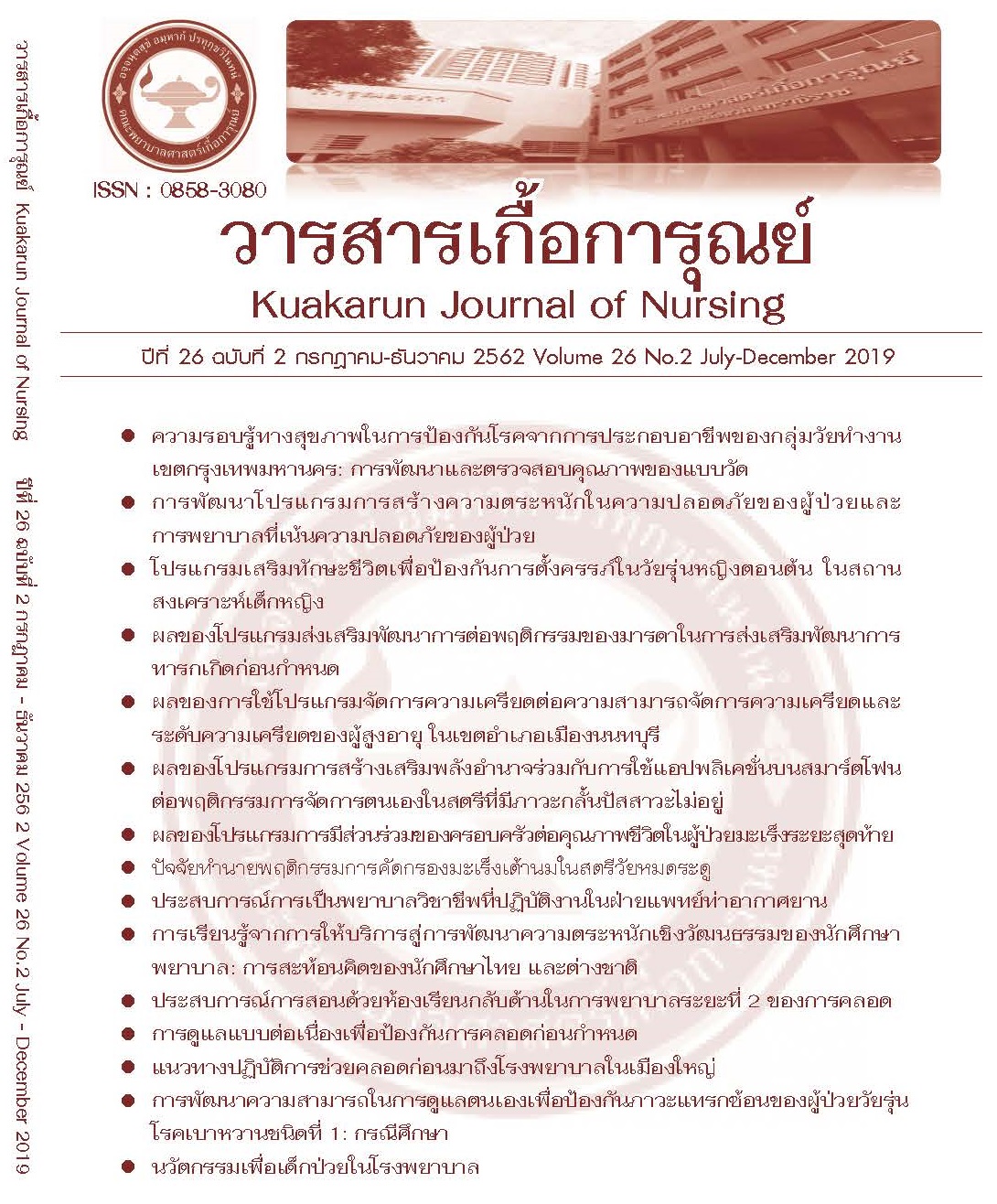ปัจจัยทำนายพฤติกรรมการคัดกรองมะเร็งเต้านมในสตรีวัยหมดระดู
คำสำคัญ:
ปัจจัยทำนาย, การคัดกรองมะเร็งเต้านม, วัยหมดระดูบทคัดย่อ
การวิจัยความสัมพันธ์เชิงทำนายนี้มีวัตถุประสงค์เพื่อศึกษาปัจจัยที่สามารถทำนายพฤติกรรมการได้รับการคัดกรองมะเร็งเต้านมของสตรีวัยหมดระดู โดยใช้กรอบแนวคิดความเชื่อด้านสุขภาพของ Becker กลุ่มตัวอย่างเป็นสตรีวัยหมดระดูที่มารับบริการในคลินิกวัยทอง โรงพยาบาลตติยภูมิในกรุงเทพมหานคร อายุระหว่าง 45-59 ปี จำนวน 145 คน คัดเลือกด้วยวิธีการสุ่มตัวอย่างแบบแบ่งชั้นเครื่องมือวิจัยในการเก็บรวบรวมเป็นแบบสอบถามประกอบด้วยข้อมูลปัจจัยส่วนบุคคล การรับรู้ความเสี่ยงของการเป็นมะเร็งเต้านม การรับรู้ความรุนแรงของการเป็นมะเร็งเต้านม การรับรู้ต่อประโยชน์ของการคัดกรองมะเร็งเต้านม การรับรู้อุปสรรคของการคัดกรองมะเร็งเต้านม การรับรู้สมรรถนะแห่งตนในการตรวจเต้านม และพฤติกรรมการคัดกรองมะเร็งเต้านม ซึ่งผ่านการตรวจสอบได้ค่าความตรงตามเนื้อหาเท่ากับ 0.80, 0.92, 0.85, 0.94 และ 1 ตามลำดับ สำหรับการรับรู้สมรรถนะแห่งตนในการตรวจเต้านมเป็นค่าความสอดคล้องคำถามได้เท่ากับ 0.80 และได้ค่าแอลฟาครอนบาค เท่ากับ 0.73, 0.86, 0.87, 0.63 และ 0.90 ตามลำดับ สำหรับพฤติกรรมการคัดกรองมะเร็งเต้านมเป็นค่าทดสอบซ้ำเท่ากับ 0.99 วิเคราะห์ข้อมูลด้วยสถิติพรรณนา และสถิติถดถอยโลจิสติค
ผลการศึกษาพบว่า (1) กลุ่มตัวอย่างมีพฤติกรรมการคัดกรองมะเร็งเต้านมที่เพียงพอ (ร้อยละ 53.79) คือ 1) การไปตรวจแมมโมแกรมทุก 1-2 ปี (ร้อยละ 13.79) 2) การตรวจแมมโมแกรมทุก 1-2 ปีร่วมกับการตรวจเต้านมด้วยตนเองทุกเดือน (ร้อยละ 2.76) 3) การไปตรวจแมมโมแกรมทุก 1-2 ปีร่วมกับการไปตรวจเต้านมโดยบุคลากรทางการแพทย์ทุกปี (ร้อยละ 19.31) และ 4) การคัดกรองมะเร็งเต้านมทั้ง 3 วิธีร่วมกันคือ ทั้งการตรวจเต้านมด้วยตนเองทุกเดือน การไปตรวจเต้านมโดยบุคลากรทางการแพทย์ทุกปี และการไปตรวจแมมโมแกรมทุก 1-2 ปี (ร้อยละ 17.93) (2) ปัจจัยที่มีอำนาจการทำนายอย่างมีนัยสำคัญทางสถิติ P<0.05 พบว่า ตัวแปรที่สำคัญทำให้ลดโอกาสของการทำนายพฤติกรรมการคัดกรองมะเร็งเต้านมที่เพียงพอ คือ การรับรู้อุปสรรคของการคัดกรองมะเร็งเต้านม OR (95%CI) = 0.93 ผลการวิจัยครั้งนี้สามารถนำไปเป็นแนวทางด้านการพัฒนาโปรแกรมให้มีพฤติกรรมการตรวจคัดกรองมะเร็งเต้านมในสตรีวัยหมดระดู โดยเน้นเรื่องการลดอุปสรรคของการคัดกรองมะเร็งเต้านม
เอกสารอ้างอิง
เมรีรัตน์ สุภาพ, จิราพร เขียงอยู่, สุธีร์ รัตนะมงคลกุล, มาลนี เหล่าไพบูลย์, และสมเกียรติ โพธิสัตย์. (2550). การรับรู้และพฤติกรรมการตรวจหามะเร็งเต้านมระยะเริ่มแรกของผู้หญิงกลุ่มอายุตั้งแต่ 30 ปีขึ้นไปในมหาวทิยาลยัขอนแก่น. วารสารวิชาการสาธารณสุข, 16(4), 586-596.
วิชัย เอกพลากร, เยาวรัตน์ ปรปักษ์ขาม, สุรศักดิ์ ฐานีพานิชสกุล, หทัยชนก พรรคเจริญ, วราภรณ์ เสถียรนพเก้า, และกนิษฐา ไทยกล้า. (2553). การสำรวจสุขภาพประชาชนไทยโดยการตรวจร่างกาย ครั้งที่ 4 พ.ศ. 2551-2. (พิมพ์ครั้งที่ 1). นนทบุรี: เดอะกราฟิโกซิสเต็มส์.
สุภาภรณ์ ตันตินันทตระกูล. (2549). พฤติกรรมป้องกันโรคมะเร็งเต้านมของพยาบาลโรงพยาบาลศูนย์ราชบุรี จังหวัดราชบุรี. (วิทยานิพนธ์ปริญญามหาบัณฑิต, มหาวิทยาลัยศรีนครินทรวิโรฒ).
สถิติสาธารณสุข พ.ศ. 2557. (2558). สืบค้นจาก https://bps.moph.go.th/sites/default/files/cancer 0.pdf
อำนาจ จิตรวรนันท์. (2556). การรักษามะเร็งเต้านม. วารสารโรงพยาบาลเจริญกรุงประชารักษ์, 9(1), 5-14.
American Cancer Society. (2015). Estimated new cases for the four major caners by sex and age group, 2015. Retrieved July 8, 2015, from https://www.cancer.org/acs/groups/ /content/@editoria/ documents/document/acspc-044511.pdf.
Berek, J. S. (2012). Berek & Novak's Gynecology. United States of America: LIPPINCOTT WILLIAMS & WILKINS.
Canadian Task Force on Preventive Health Care. (2015). CTFPHC Guidelines: Breast cancer clinician CBE/BSE recommendation. Retrieved July 18, 2015, from https://canadiantaskforce.ca/ctfphc-guidelines/2011-breast-cancer/clinician-cbe-bse-recommendation/.
Miller, A. B., & Baines, C. J. (2011). The role of clinical breast examination and breast self-examination. Preventive Medicine, 53(3), 118-120.
Miller, N. H. and Jensen, R. T. (2008). Giffen behavior and subsistence consumption. American Economic Review, 98(4), 1553-77.
National Cancer Institute. (2015). Risk and protective factors. Retrieved July 19, 2015, from https://www.cancer.gov/ types/breast/hp/breast-treatment-pdq#section/ _1.
Newton E. V. and Grethlein S. J. (2015). Breast cancer screening. Retrieved July 18, 2015, from https://emedicine.medscape.com/article/1945498-overview.
Ritte, R., Lukanova A., Tjønneland A., Olsen A., Overvad K., Mesrine S., … Kaaks, R. (2013). Height, age at menarche and risk of hormone receptor-positive and negative breast cancer: A cohort study. Int Journal Cancer, 132(11), 2619-29. doi: 10.1002/ijc.27913.
Yurdakos, K., Gulhan, Y. B., Unalan, D., & Ozturk, A. (2013). Knowledge, attitudes and behavior of women working in government hospitals regarding breast self-examination. Asian Pacific Journal Cancer Prevention, 14(8), 4829-4834.















